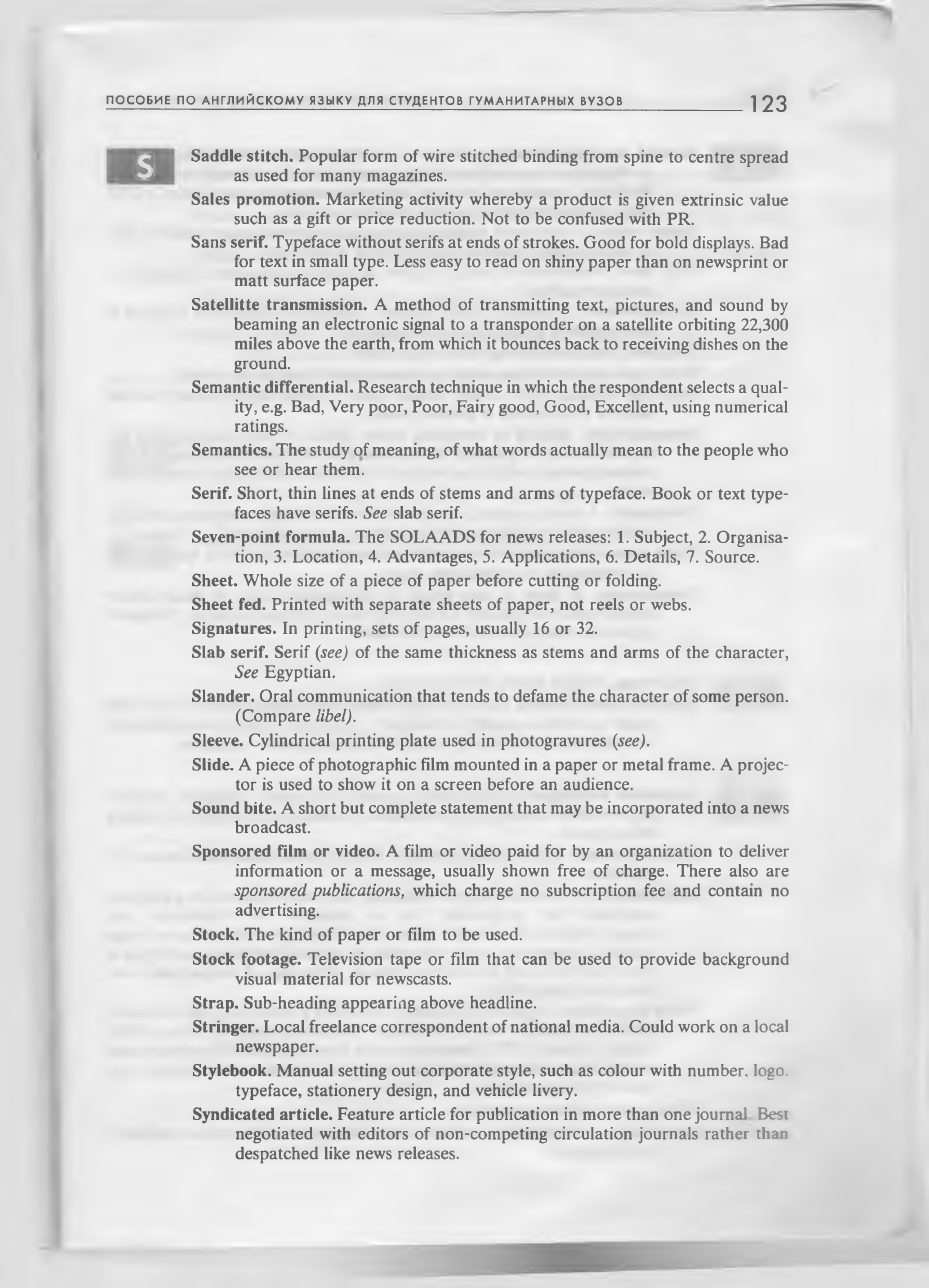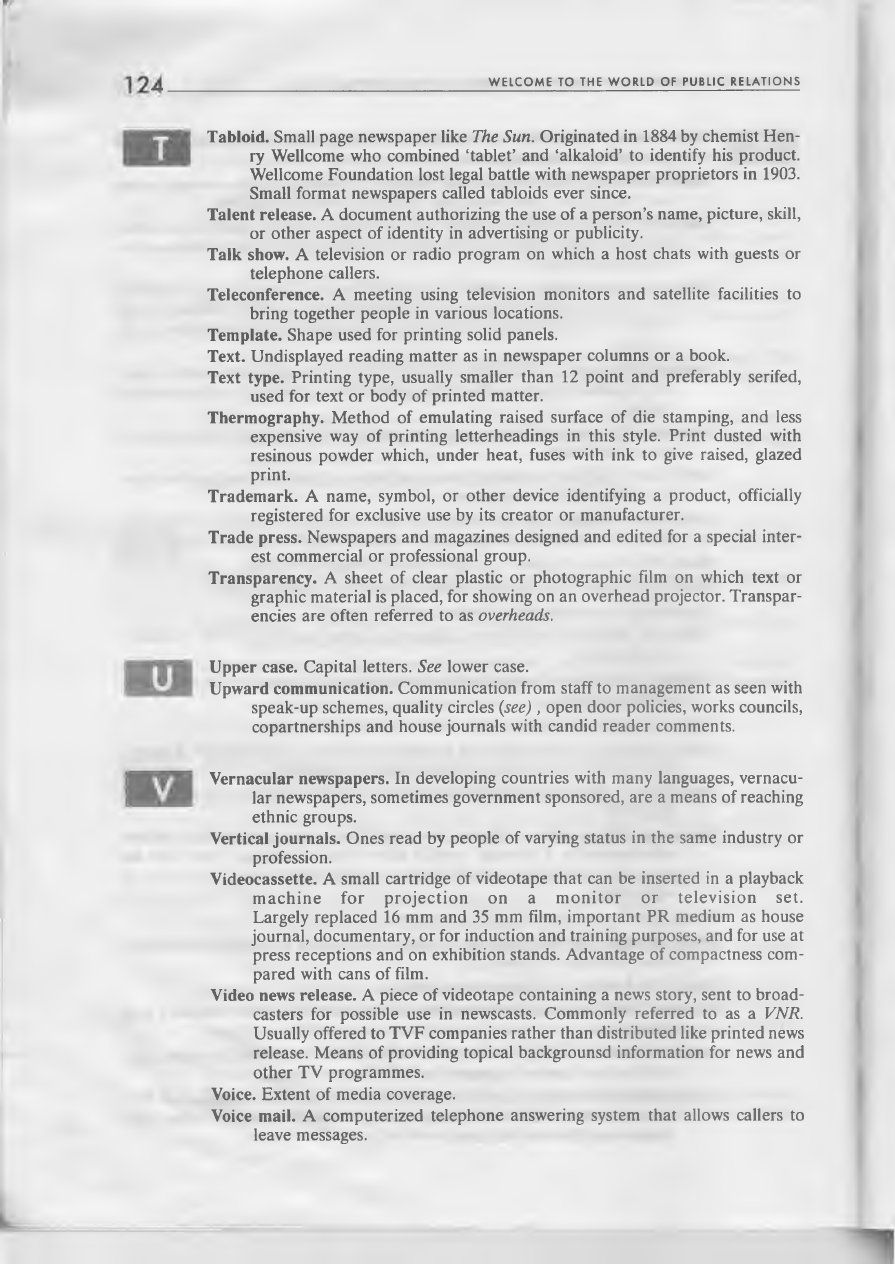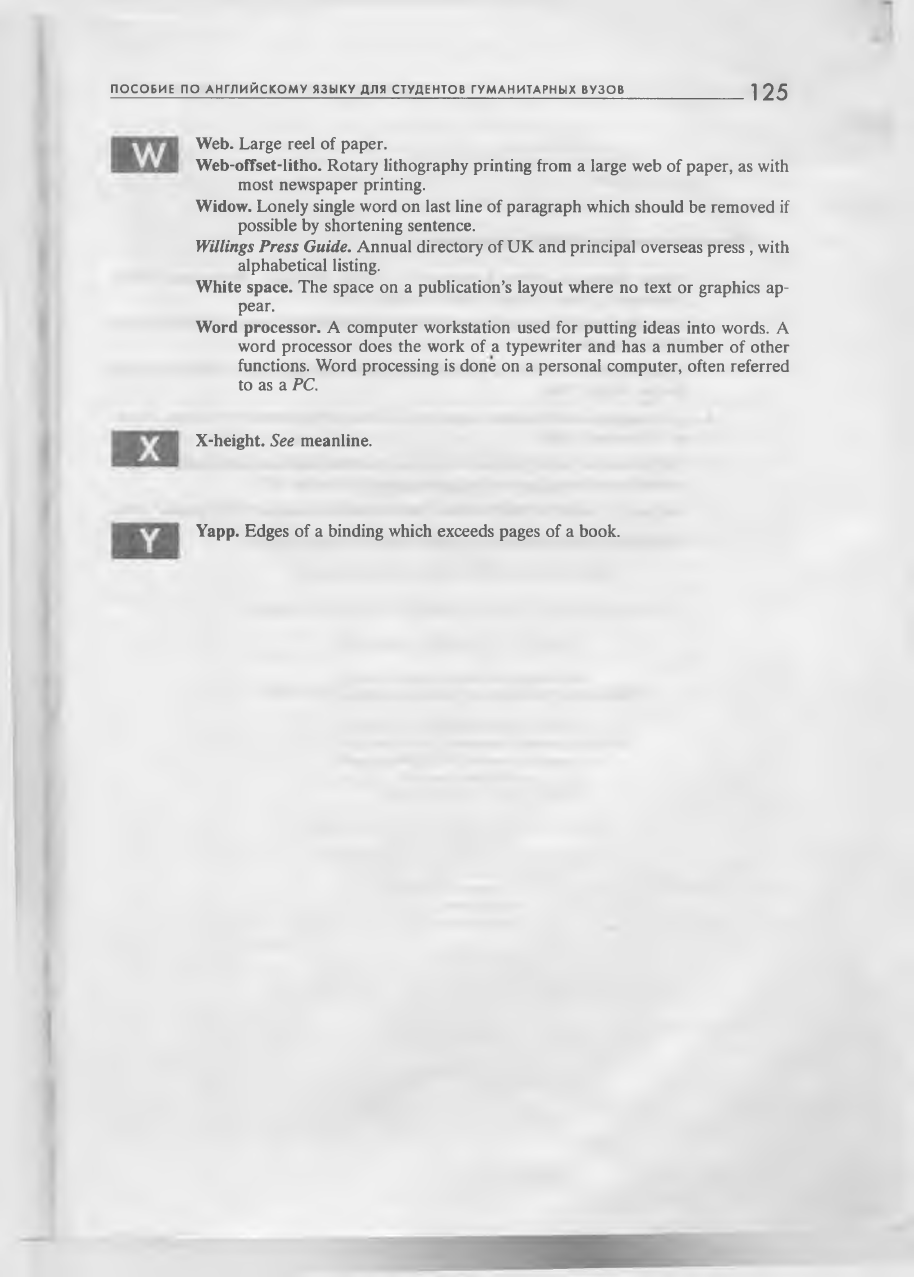ВУЗ: Не указан
Категория: Не указан
Дисциплина: Не указана
Добавлен: 01.04.2021
Просмотров: 1447
Скачиваний: 7

П О С О Б И Е П О А Н Г Л И Й С К О М У Я З Ы К У Д Л Я С Т У Д Е Н Т О В Г У М А Н И Т А Р Н Ы Х В У З О В
123
S
Saddle stitch.
Popular form of wire stitched binding from spine to centre spread
as used for many magazines.
Sales promotion.
Marketing activity whereby a product is given extrinsic value
such as a gift or price reduction. Not to be confused with PR.
Sans serif.
Typeface without serifs at ends of strokes. Good for bold displays. Bad
for text in small type. Less easy to read on shiny paper than on newsprint or
matt surface paper.
Satellitte transmission.
A method of transmitting text, pictures, and sound by
beaming an electronic signal to a transponder on a satellite orbiting 22,300
miles above the earth, from which it bounces back to receiving dishes on the
ground.
Semantic differential.
Research technique in which the respondent selects a qual
ity, e.g. Bad, Very poor, Poor, Fairy good, Good, Excellent, using numerical
ratings.
Semantics.
The study of meaning, of what words actually mean to the people who
see or hear them.
Serif.
Short, thin lines at ends of stems and arms of typeface. Book or text type
faces have serifs.
See
slab serif.
Seven-point formula.
The SOLAADS for news releases: 1. Subject, 2. Organisa
tion, 3. Location, 4. Advantages, 5. Applications, 6. Details, 7. Source.
Sheet.
Whole size of a piece of paper before cutting or folding.
Sheet fed.
Printed with separate sheets of paper, not reels or webs.
Signatures.
In printing, sets of pages, usually 16 or 32.
Slab serif.
Serif
(see)
of the same thickness as stems and arms of the character,
See
Egyptian.
Slander.
Oral communication that tends to defame the character of some person.
(Compare
libel).
Sleeve.
Cylindrical printing plate used in photogravures
(see).
Slide.
A piece of photographic film mounted in a paper or metal frame. A projec
tor is used to show it on a screen before an audience.
Sound bite.
A short but complete statement that may be incorporated into a news
broadcast.
Sponsored film or video.
A film or video paid for by an organization to deliver
information or a message, usually shown free of charge. There also are
sponsored publications,
which charge no subscription fee and contain no
advertising.
Stock.
The kind of paper or film to be used.
Stock footage.
Television tape or film that can be used to provide background
visual material for newscasts.
Strap.
Sub-heading appearing above headline.
Stringer.
Local freelance correspondent of national media. Could work on a local
newspaper.
Stylebook.
Manual setting out corporate style, such as colour with number, logo,
typeface, stationery design, and vehicle livery.
Syndicated article.
Feature article for publication in more than one journal Besi
negotiated with editors of non-competing circulation journals rather than
despatched like news releases.

W E L C O M E T O T H E W O R L D O F P U B L I C R E L A T I O N S
Tabloid.
Small page newspaper like
The Sun.
Originated in 1884 by chemist Hen
ry Wellcome who combined ‘tablet’ and ‘alkaloid’ to identify his product.
Wellcome Foundation lost legal battle with newspaper proprietors in 1903.
Small format newspapers called tabloids ever since.
Talent release.
A document authorizing the use of a person’s name, picture, skill,
or other aspect of identity in advertising or publicity.
Talk show.
A television or radio program on which a host chats with guests or
telephone callers.
Teleconference.
A meeting using television monitors and satellite facilities to
bring together people in various locations.
Template.
Shape used for printing solid panels.
Text.
Undisplayed reading matter as in newspaper columns or a book.
Text type.
Printing type, usually smaller than 12 point and preferably serifed,
used for text or body of printed matter.
Thermography.
Method of emulating raised surface of die stamping, and less
expensive way of printing letterheadings in this style. Print dusted with
resinous powder which, under heat, fuses with ink to give raised, glazed
print.
Trademark.
A name, symbol, or other device identifying a product, officially
registered for exclusive use by its creator or manufacturer.
Trade press.
Newspapers and magazines designed and edited for a special inter
est commercial or professional group.
Transparency.
A sheet of clear plastic or photographic film on which text or
graphic material is placed, for showing on an overhead projector. Transpar
encies are often referred to as
overheads.
Upper case.
Capital letters.
See
lower case.
Upward communication.
Communication from staff to management as seen with
speak-up schemes, quality circles
(see)
, open door policies, works councils,
copartnerships and house journals with candid reader comments.
Vernacular newspapers. In
developing countries with many languages, vernacu
lar newspapers, sometimes government sponsored, are a means of reaching
ethnic groups.
Vertical journals.
Ones read by people of varying status in the same industry or
profession.
Videocassette.
A small cartridge of videotape that can be inserted in a playback
m achine
for
p ro jectio n
on
a
m o n ito r
or
television
set.
Largely replaced 16 mm and 35 mm film, important PR medium as house
journal, documentary, or for induction and training purposes, and for use at
press receptions and on exhibition stands. Advantage of compactness com
pared with cans of film.
Video news release.
A piece of videotape containing a news story, sent to broad
casters for possible use in newscasts. Commonly referred to as a
VNR.
Usually offered to
TVF
companies rather than distributed like printed news
release. Means of providing topical backgrounsd information for news and
other
TV
programmes.
Voice.
Extent of media coverage.
Voice mail.
A computerized telephone answering system that allows callers to
leave messages.

П О С О Б И Е П О А Н Г Л И Й С К О М У Я З Ы К У Д Л Я С Т У Д Е Н Т О В Г У М А Н И Т А Р Н Ы Х В У З О В
125
Web.
Large reel of paper.
Web-offset-litho.
Rotary lithography printing from a large web of paper, as with
most newspaper printing.
Widow.
Lonely single word on last line of paragraph which should be removed if
possible by shortening sentence.
Willings Press Guide.
Annual directory of UK and principal overseas press , with
alphabetical listing.
White space.
The space on a publication’s layout where no text or graphics ap
pear.
Word processor.
A computer workstation used for putting ideas into words. A
word processor does the work of a typewriter and has a number of other
functions. Word processing is done on a personal computer, often referred
to as a
PC.
X-height. See meanline.
Yapp.
Edges of a binding which exceeds pages of a book.

126
W E L C O M E T O T H E W O R L D O F P U B L I C R E L A T I O N S
С п и со к и сп ол ьзо ван н ой ли тератур ы
1. Wilcox, Dennis L., Nolte, Lawrence W. “Public Relations. Writing and Media
Techniques”. Harper Collins College Publishers, 1995
2. Duffy, Margaret. “How to Communicate to a Postliterate World”. Communication
World, November 1991.
3. Brynes, Sondra J. “Privacy vs. Publicity. Flip Sides of the Same Coin”. Public Relations
Review, Winter, 1990.
4. А.С.Манукян, С.Ю.Кашкин. Англо-русский полный юридический словарь. Моск
ва, “Советник”, 1993.
5. Е.И. Курьянов. Англо-русский словарь по средствам массовой информации. “Мос
ковская международная школа переводчиков”. Москва, 1993.
6. Американа. Англо-русский лингвострановедческий словарь. “Полиграмма”, 1996.
7. The Oxford Russian Dictionary. Oxford University Press, 1997.